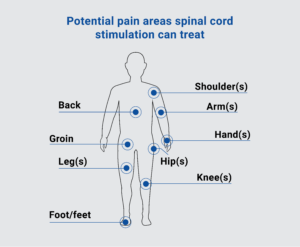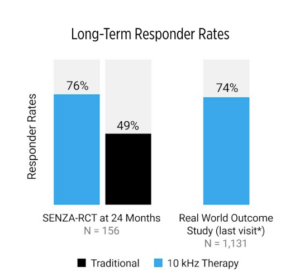Is a Spinal Cord Stimulator Right for Me?

When you haven’t found relief with other chronic pain treatment options like pain medication, surgery, or injections, it could be time to start researching getting a spinal cord stimulator to manage your pain.
You probably have a lot of questions about spinal cord stimulators – like “Is a spinal cord stimulator right for me?” and “Will a spinal cord stimulator help relieve my pain?” These aren’t only good questions; they’re important ones and we’re going to help you answer them.
The type of pain spinal cord stimulation works best for
We’ll first need to go into the type of pain spinal cord stimulation best relieves.
Acute vs. chronic pain
Pain can either be acute or chronic.
How do you tell the difference between acute and chronic back pain?
You can tell by the timeframe of your pain.
Acute pain: develops over a short period of time, lasts less than six months, and heals with time. Acute pain tends to be sharp. It happens suddenly and is often a result of an injury like a broken bone, burn, cut, or surgery or illness – like strep throat or appendicitis.
Chronic pain: lasts longer than 6 months, is constant, and continues even after treatment. It’s persistent, debilitating, and gets in the way of everyday life. Illness, past injuries, or damage to nerves can cause chronic pain. Many times, chronic pain continues even after an injury has fully healed. For some people, chronic pain appears without any explanation at all.
How everyone experiences pain is unique and chronic pain can be experienced on different levels of severity.
Spinal cord stimulation treats chronic pain that is moderate to severe. Moderate to severe pain can disrupt your sleep, interfere with everyday life, cause you to miss work or social gatherings, make it difficult to sit, stand, or walk, etc.
Mechanical vs. nerve pain
Feeling pain is a normal protective function. Sensory receptors throughout our body detect pain and send signals to our brain to process and react. There are two main types of chronic pain – mechanical and nerve pain.
Mechanical pain: when bones, ligaments, tendons, or muscles are damaged or strained from an injury or overuse. Mechanical pain can also develop from habits, such as poor posture and incorrect bending and lifting motions. It usually feels tender, throbbing, or stiff.
Mechanical pain usually increases or decreases depending on if you put weight on it or the position you’re in. For example, if your knee hurts when you walk but feels better when you sit down or if your back feels better once you lie down – that’s most likely mechanical pain.
Treatment for mechanical pain is best accomplished by treating the source.
Nerve pain: Sometimes nerves are damaged by disease, trauma, and even medications. This can lead to ongoing pain sensations – even when there isn’t an injury or any obvious source of pain. This is called nerve pain. It often feels like continuous burning, shooting, shock-like and often is associated with abnormal sensations like tingling, numbness, pins-and-needles.
Spinal cord stimulation is most effective for difficult to treat nerve-related chronic pain.

How do you tell the difference between nerve and mechanical back pain?
A complete evaluation with a pain management physician will help you understand what kind of pain you’re experiencing.
How we experience pain is unique and many people have a mix of both types. If most of your pain is chronic and nerve-related, spinal cord stimulation could be a very effective treatment option for you.
Who is a good candidate for a spinal cord stimulator?
To determine if you’re a candidate for spinal cord stimulation, your physician will look at:
- How long you’ve had pain
- How much your pain impacts your day-to-day life
- The severity of your pain
- Your pain characteristics
- Previous treatment options you’ve tried and didn’t find relief
- What previous surgeries or procedures you’ve had
You could be a good candidate for spinal cord stimulation if:
- You have nerve-related pain
- Your pain is constant and chronic
- Your pain is in your back, trunk, or limbs
- You still have pain even after trying other treatment options like surgery, pain medications, or injections
Specific conditions that are often treated well with spinal cord stimulation include painful diabetic neuropathy, pain after back surgery (“Failed Back Surgery Syndrome”), Sciatica, and nerve pain in your arms, legs, feet, hands, back, and buttock.
Who is not a good candidate for a spinal cord stimulator?
You may not be the best candidate for spinal cord stimulation if:
- Most of your pain is acute
- Most of your pain is mechanical
Specific pain types and conditions that aren’t as effectively treated with spinal cord stimulation include bone pain, tissue pain, muscle pain, cancer pain, arthritis, and fibromyalgia.
How does spinal cord stimulation relieve my pain?
Spinal cord stimulation works best for chronic nerve pain and here’s why- we know chronic nerve pain is caused by damaged nerves that are overproducing and sending pain signals through your spinal cord to your brain.
Well, spinal cord stimulation works by safely blocking and reducing pain signals. When your pain signals are reduced, you experience less pain.
I’ve tried everything else, why should I try a spinal cord stimulator?
Spinal cord stimulation is a well-established approach to managing chronic pain and there are many unique benefits:
- It’s proven to be very successful for many people who have tried other treatment options
- It’s a drug-free option and it’s not addictive
- It has fewer side effects than pain medication and it doesn’t cloud your thoughts, cause drowsiness or constipation
- It’s minimally invasive and doesn’t require a major surgery
- You can try it before you decide to make sure you experience relief
Learn more about what to expect.

While traditional spinal cord stimulators have been used to manage pain for over 50 years, a study came out in 2015 that compared the pain relief experienced by people with traditional SCS and people with a newer spinal cord stimulator, HFX™.
The study found that many more people experienced significantly better and longer-lasting pain relief from chronic back and leg pain with HFX than other spinal cord stimulation systems1,2. Nearly 80% of people experienced at least 50% pain relief with HFX compared to only 49% of people with traditional SCS.
Hear how Jerry found relief with HFX:
HFX is covered by all major commercial insurance plans, Medicaid, Medicare, Tricare, and workers comp in all states except Washington. Find more information about costs and insurance.
Find out if HFX spinal cord stimulation is right for you
Spinal cord stimulation could be a very effective treatment option for you if most of your pain is chronic and nerve-related.
To find out if HFX could relieve your chronic pain, the first step is to take a short assessment today. At the end, you can request a call from an HFX Coach who will answer any questions you have and help you find an HFX doctor in your area.
Summary
- Spinal cord stimulation is most effective for chronic nerve pain
- Spinal cord stimulation doesn’t work best for acute and mechanical pain
- Spinal cord stimulation is proven to be very successful for many people who have tried other treatment options like pain medications, surgery, and injections
- HFX spinal cord stimulation has the highest demonstrated success rate for relieving back and leg pain compared to other spinal cord stimulation options 1,2
Sources
- Kapural L, et al. Comparison of 10-kHz High-Frequency and Traditional Low-Frequency Spinal Cord Stimulation for the Treatment of Chronic Back and Leg Pain: 24-month Results from a Multicenter, Randomized, Controlled Pivotal Trial. Neurosurgery. Published 09 2016
- Stauss, T, et al. A multicenter real-world review of 10 kHz SCS outcomes for treatment of chronic trunk and/or limb pain. Annals of Clinical and Translational Neurology. Jan. 22, 2019. *Mean time from implant to last visit is nine months.
Popular Posts
Take our short assessment to find out if HFX is right for you.
Start NowHFX is covered by all major commercial insurance plans, Medicare, Medicaid, and Tricare.
DOWNLOAD INFORMATION BROCHURERelevant Reads
What to Expect at Your Nevro HFX Consultation
You’ve decided to explore Nevro HFX as a treatment option for your chronic pain. Congratulations! That’s the first step in finding a long-term pain relief solution that doesn’t require drugs or major invasive surgery. A…
How to Choose the Right Pain Management Doctor
If you’ve been living with chronic pain for a long time, you’ve probably tried a wide range of treatment options recommended by your primary care provider. Maybe you’ve tried over-the-counter and prescription medications, physical therapy,…
Why Do I Need a Psychological Evaluation for a Spinal Cord Stimulator?
A spinal cord stimulator is a highly effective treatment option for managing chronic pain. It’s a solution for many people who have tried other ways to manage their pain but haven’t found success with medications,…
How long have you been suffering from pain?
Where is your pain located?
Select all that apply:
What is your average daily pain level?
On a scale from 1 to 10, with 1 representing minimal pain and 10 representing
the most severe pain, rate your pain.
Which treatments have you tried?
What statement describes you best?
Please select your primary insurance:
HFX is covered by all major insurance plans, including Medicare and Tricare.
Commercial insurance is typically offered through your employer or health care exchange. Examples of commercial insurance providers include Aetna, Anthem, Cigna, Kaiser, Regional Blue Cross Blue Shield, and United Healthcare.
Thank you for sharing your experience.
At this time, it looks like you might not be an appropriate candidate for HFX. The next best step is to talk with the physician who is treating your pain about your treatment options.
Learn MoreThank you for your responses!
One of the qualifications for HFX is that you need to experience pain for longer than 6 months.
You may not be ready for HFX now, however if your pain lasts longer than 6 months, please come back to see if you qualify.
Learn MoreThank you for your responses!
One of the qualifications for HFX is that you need to experience moderate to severe pain.
You may not be ready for HFX now, however if your pain severity increases, please come back to see if you qualify.
Learn MoreThank you for your responses!
Based on your assessment, it looks like HFX is not the right treatment for you at this time.
Learn MoreGood news!
Based on your responses, you are a candidate for HFX!
Fill in your information below to get your doctor discussion guide and educational information about HFX.
Fill in your information below to connect with your HFX Coach and receive your doctor discussion guide. Your HFX Coach is a real person assigned to you who will answer your questions and help you find an HFX doctor.
Agree to terms
By clicking ‘I agree & submit’, you agree to receive automated SMS texts from Nevro at the mobile number provided and agree to Nevro’s Text Message Terms of Service & Privacy Notice. Message and data rates may apply. Message frequency varies. You can opt-out at any time by texting STOP to 35788. You can also text HELP to 35788 for HELP. You also agree to email and phone communications from Nevro and opportunities to participate in Nevro led research panels and quantitative surveys. You understand that you can choose to participate or decline to participate in any marketing panel. You understand that you can opt-out of further advertising and/or marketing research communications from Nevro by clicking unsubscribe in the email or providing a detailed request to opt-out@nevro.com.
All information will be used in accordance with Nevro’s Privacy Notice.
Looks like you have recently taken the assessment.
Would you like to update your responses?
Your responses are being submitted. Please wait – we’re sending you to a page with more information about HFX.
Please don't click the back button or close your browser. This may take a few seconds.
Your responses have been saved.
Thank you for your time.
Your results and discussion guide will be on their way shortly.
Please find a copy at the email address provided.
Thank you for your time.
We did not update your responses. Your results and discussion guide will be based on your previous responses. Please find a copy at the email address provided.
YOU ARE ABOUT TO EXIT FOR A WEBSITE INTENDED FOR THE RESIDENTS OF ANOTHER COUNTRY OR REGION.
Please be aware that the website you have requested is intended for the residents of a particular country or region, as noted on that site. As a result, the site may contain information on medical devices and other products or uses of those products that are not approved in other countries or regions.
Do you wish to continue?
YOU ARE ABOUT TO ACCESS A WEBSITE INTENDED FOR THE RESIDENTS OF A PARTICULAR COUNTRY OR REGION.
Please be aware that the website you have requested is intended for the residents of a particular country or region, as noted on that site. As a result, the site may contain information on medical devices and other products or uses of those products that are not approved in your country or region.